Report on Numeracy and Data Analysis: Telephone Bill Data Analysis
VerifiedAdded on 2023/01/11
|9
|1253
|49
Report
AI Summary
This report delves into the relationship between numeracy and data analysis by examining a 10-day telephone bill. It presents the data in both table and chart formats, including column and line charts for visual representation. The core of the report involves the calculation of key statistical measur...
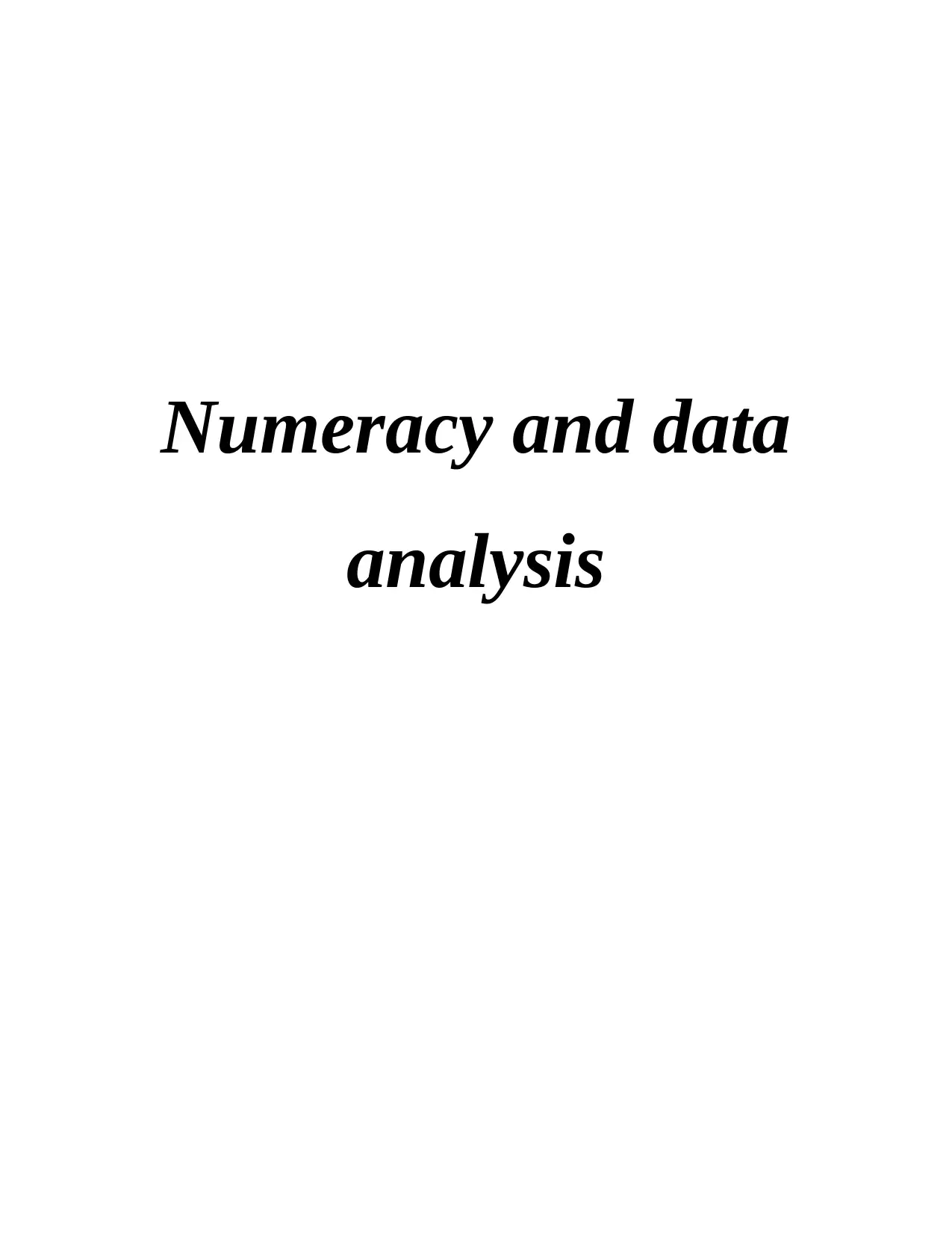
Numeracy and data
analysis
analysis
Paraphrase This Document
Need a fresh take? Get an instant paraphrase of this document with our AI Paraphraser
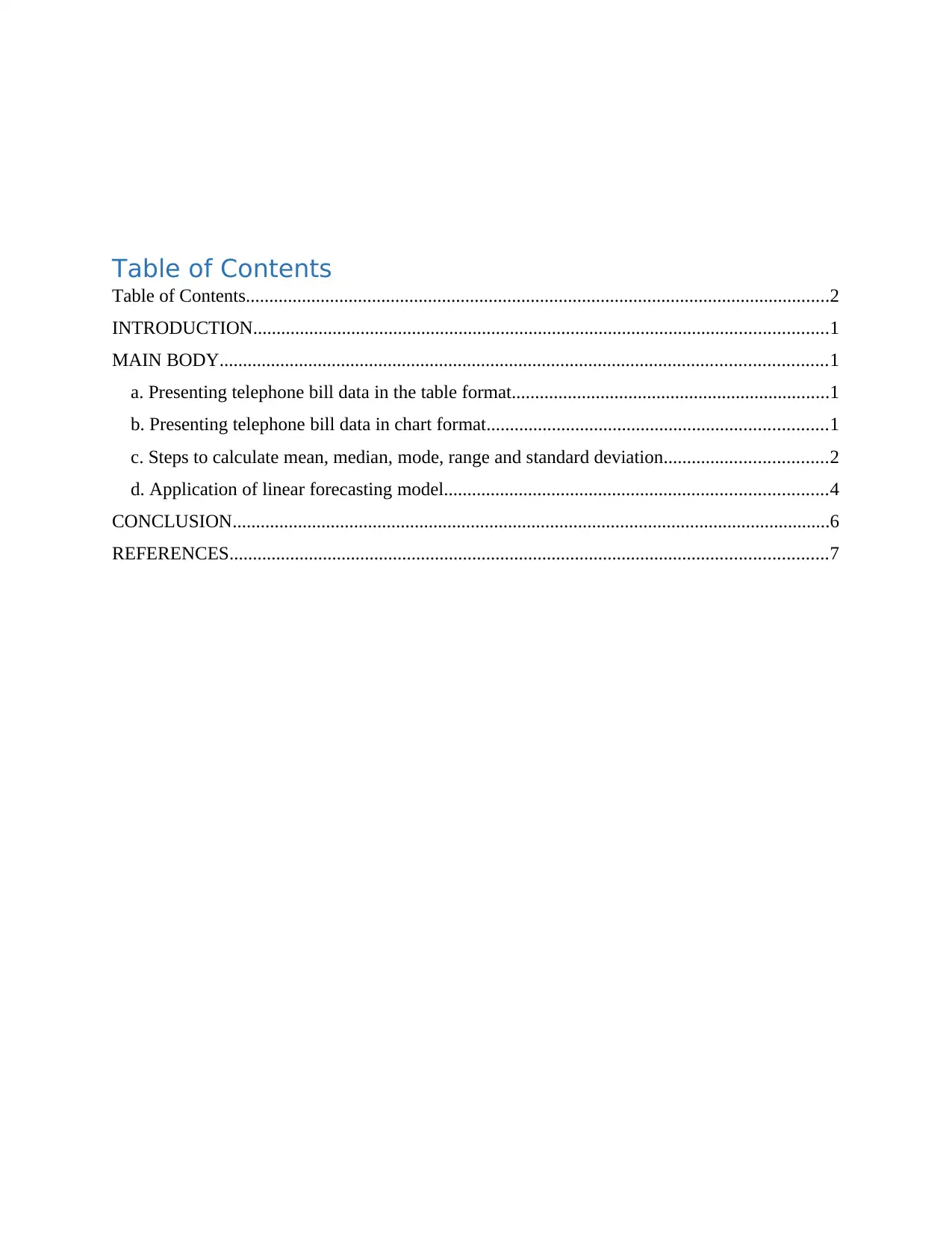
Table of Contents
Table of Contents.............................................................................................................................2
INTRODUCTION...........................................................................................................................1
MAIN BODY..................................................................................................................................1
a. Presenting telephone bill data in the table format....................................................................1
b. Presenting telephone bill data in chart format.........................................................................1
c. Steps to calculate mean, median, mode, range and standard deviation...................................2
d. Application of linear forecasting model..................................................................................4
CONCLUSION................................................................................................................................6
REFERENCES................................................................................................................................7
Table of Contents.............................................................................................................................2
INTRODUCTION...........................................................................................................................1
MAIN BODY..................................................................................................................................1
a. Presenting telephone bill data in the table format....................................................................1
b. Presenting telephone bill data in chart format.........................................................................1
c. Steps to calculate mean, median, mode, range and standard deviation...................................2
d. Application of linear forecasting model..................................................................................4
CONCLUSION................................................................................................................................6
REFERENCES................................................................................................................................7
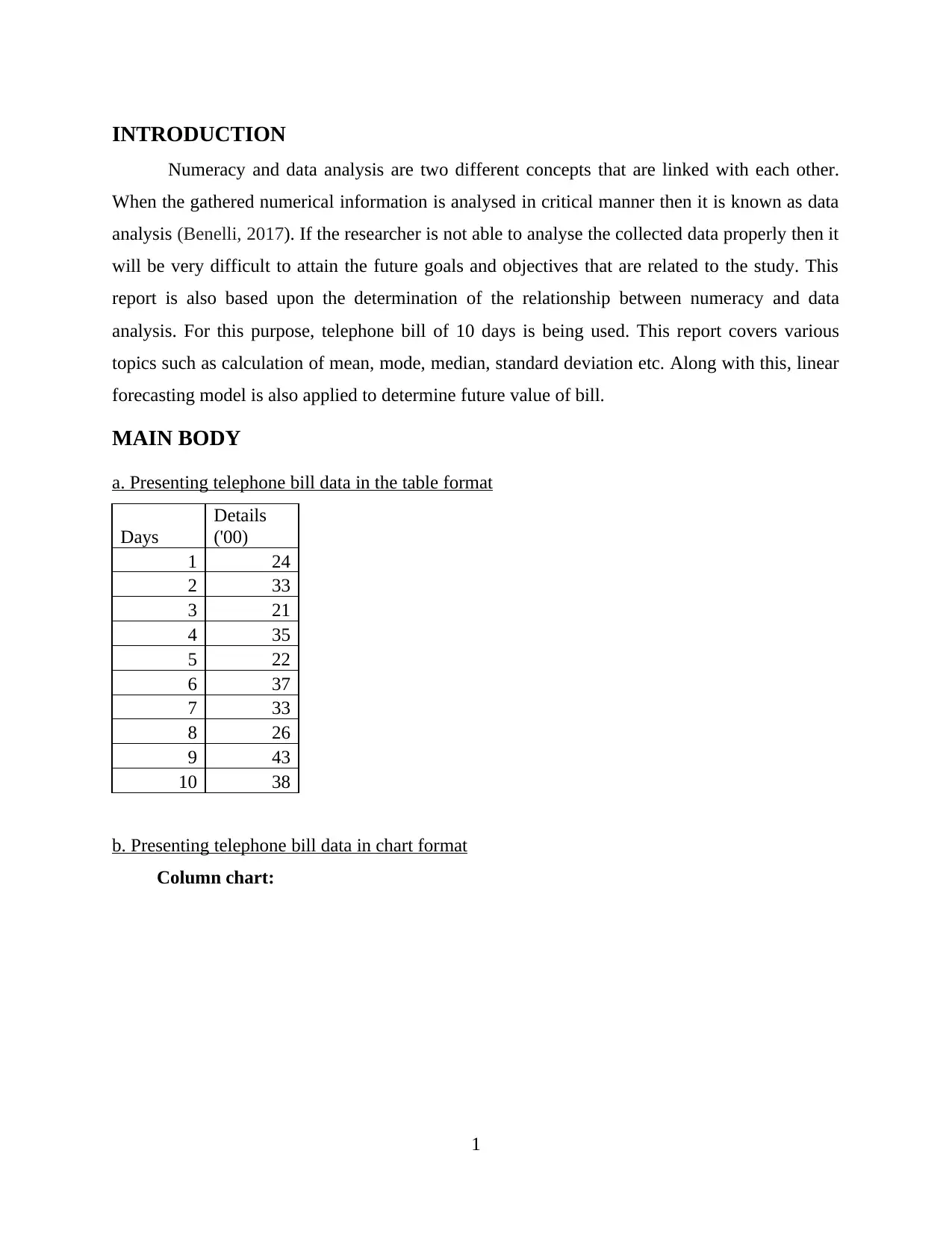
INTRODUCTION
Numeracy and data analysis are two different concepts that are linked with each other.
When the gathered numerical information is analysed in critical manner then it is known as data
analysis (Benelli, 2017). If the researcher is not able to analyse the collected data properly then it
will be very difficult to attain the future goals and objectives that are related to the study. This
report is also based upon the determination of the relationship between numeracy and data
analysis. For this purpose, telephone bill of 10 days is being used. This report covers various
topics such as calculation of mean, mode, median, standard deviation etc. Along with this, linear
forecasting model is also applied to determine future value of bill.
MAIN BODY
a. Presenting telephone bill data in the table format
Days
Details
('00)
1 24
2 33
3 21
4 35
5 22
6 37
7 33
8 26
9 43
10 38
b. Presenting telephone bill data in chart format
Column chart:
1
Numeracy and data analysis are two different concepts that are linked with each other.
When the gathered numerical information is analysed in critical manner then it is known as data
analysis (Benelli, 2017). If the researcher is not able to analyse the collected data properly then it
will be very difficult to attain the future goals and objectives that are related to the study. This
report is also based upon the determination of the relationship between numeracy and data
analysis. For this purpose, telephone bill of 10 days is being used. This report covers various
topics such as calculation of mean, mode, median, standard deviation etc. Along with this, linear
forecasting model is also applied to determine future value of bill.
MAIN BODY
a. Presenting telephone bill data in the table format
Days
Details
('00)
1 24
2 33
3 21
4 35
5 22
6 37
7 33
8 26
9 43
10 38
b. Presenting telephone bill data in chart format
Column chart:
1
⊘ This is a preview!⊘
Do you want full access?
Subscribe today to unlock all pages.

Trusted by 1+ million students worldwide

The above column chart shows changes in telephone bill of an individual with days for
10 consecutive days.
Line chart:
From the above line chart, it has been analysed that telephone bill expenses of an
individual change with days (Gloor and Reid, 2016). The lowest bill was 21 for 3rd day and the
highest bill was 43 for 9th day.
c. Steps to calculate mean, median, mode, range and standard deviation
To determine value of mean, median, mode, range and standard deviation following table
is generated:
2
10 consecutive days.
Line chart:
From the above line chart, it has been analysed that telephone bill expenses of an
individual change with days (Gloor and Reid, 2016). The lowest bill was 21 for 3rd day and the
highest bill was 43 for 9th day.
c. Steps to calculate mean, median, mode, range and standard deviation
To determine value of mean, median, mode, range and standard deviation following table
is generated:
2
Paraphrase This Document
Need a fresh take? Get an instant paraphrase of this document with our AI Paraphraser

Days Details ('00)
1 24
2 33
3 21
4 35
5 22
6 37
7 33
8 26
9 43
10 38
Mean 31.2
Mode 33
Median 22
Standard
deviation 7.12
Max 43
Min 21
Range 22
Mean: When the total of all the values of data series is divided by the number of values
then the results are known as mean. It is the average number of data series.
Formula to calculate mean: ∑x / N
= 312 / 10
= 31.2
Median: The middle number in data set is considered as median which is calculated by
analysing the middle observation of data set.
Formula to calculate median: N / 2
= 10 / 2
= 5th value in data series which is 22 (Median)
Mode: A value which gets repeated in the data series is known as mode. When there is
no value which is repeating in the series then there will be no mean.
Standard deviation: Dispersion is one of the main elements which help to analyse that
the collected information is able to provide accurate answers for the questions or not (Greenacre,
2018). Standard deviation is the measure which is used to calculate and analyse the dispersion in
the data set. While calculating it following table is generated:
3
1 24
2 33
3 21
4 35
5 22
6 37
7 33
8 26
9 43
10 38
Mean 31.2
Mode 33
Median 22
Standard
deviation 7.12
Max 43
Min 21
Range 22
Mean: When the total of all the values of data series is divided by the number of values
then the results are known as mean. It is the average number of data series.
Formula to calculate mean: ∑x / N
= 312 / 10
= 31.2
Median: The middle number in data set is considered as median which is calculated by
analysing the middle observation of data set.
Formula to calculate median: N / 2
= 10 / 2
= 5th value in data series which is 22 (Median)
Mode: A value which gets repeated in the data series is known as mode. When there is
no value which is repeating in the series then there will be no mean.
Standard deviation: Dispersion is one of the main elements which help to analyse that
the collected information is able to provide accurate answers for the questions or not (Greenacre,
2018). Standard deviation is the measure which is used to calculate and analyse the dispersion in
the data set. While calculating it following table is generated:
3
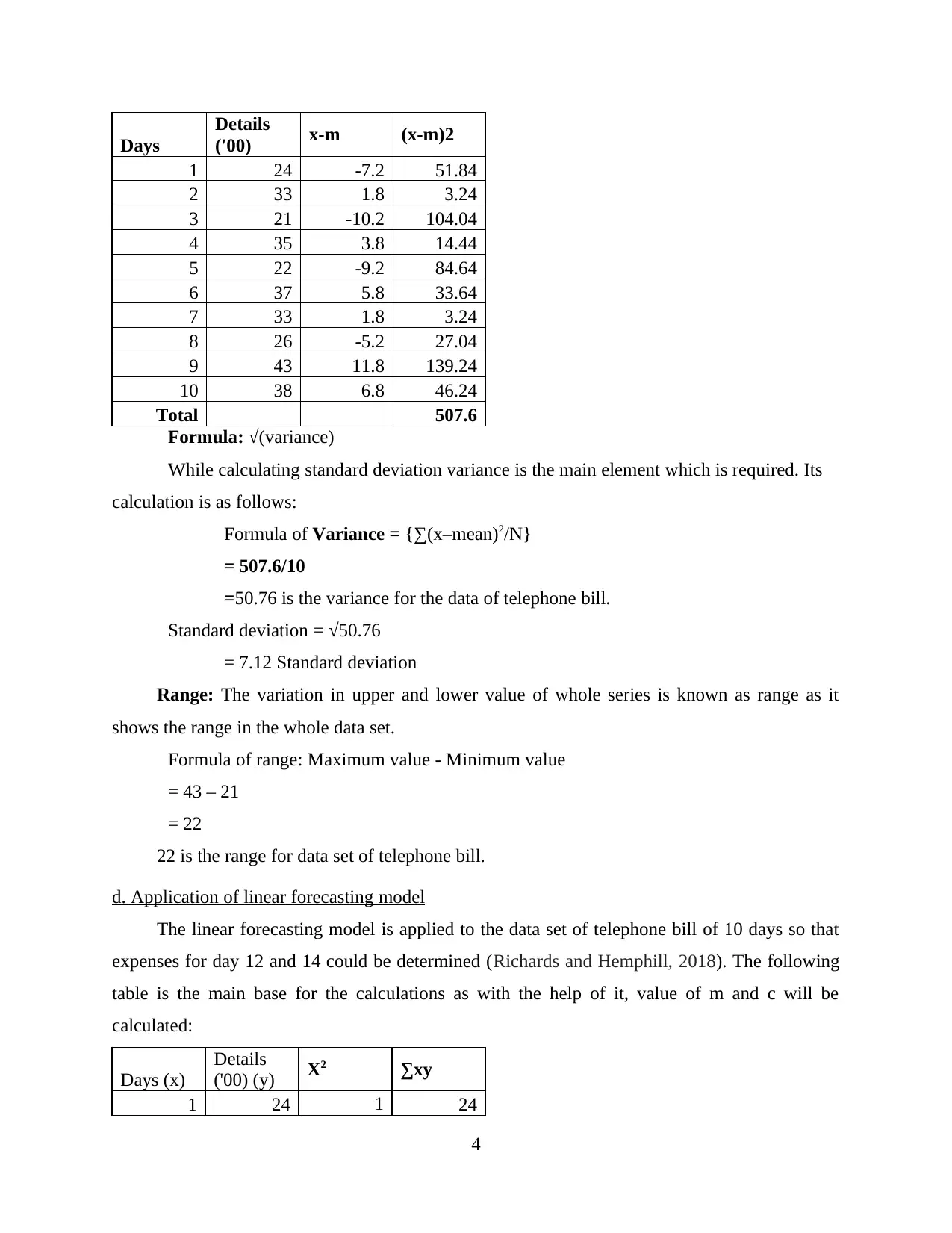
Days
Details
('00) x-m (x-m)2
1 24 -7.2 51.84
2 33 1.8 3.24
3 21 -10.2 104.04
4 35 3.8 14.44
5 22 -9.2 84.64
6 37 5.8 33.64
7 33 1.8 3.24
8 26 -5.2 27.04
9 43 11.8 139.24
10 38 6.8 46.24
Total 507.6
Formula: √(variance)
While calculating standard deviation variance is the main element which is required. Its
calculation is as follows:
Formula of Variance = {∑(x–mean)2/N}
= 507.6/10
=50.76 is the variance for the data of telephone bill.
Standard deviation = √50.76
= 7.12 Standard deviation
Range: The variation in upper and lower value of whole series is known as range as it
shows the range in the whole data set.
Formula of range: Maximum value - Minimum value
= 43 – 21
= 22
22 is the range for data set of telephone bill.
d. Application of linear forecasting model
The linear forecasting model is applied to the data set of telephone bill of 10 days so that
expenses for day 12 and 14 could be determined (Richards and Hemphill, 2018). The following
table is the main base for the calculations as with the help of it, value of m and c will be
calculated:
Days (x)
Details
('00) (y) X2 ∑xy
1 24 1 24
4
Details
('00) x-m (x-m)2
1 24 -7.2 51.84
2 33 1.8 3.24
3 21 -10.2 104.04
4 35 3.8 14.44
5 22 -9.2 84.64
6 37 5.8 33.64
7 33 1.8 3.24
8 26 -5.2 27.04
9 43 11.8 139.24
10 38 6.8 46.24
Total 507.6
Formula: √(variance)
While calculating standard deviation variance is the main element which is required. Its
calculation is as follows:
Formula of Variance = {∑(x–mean)2/N}
= 507.6/10
=50.76 is the variance for the data of telephone bill.
Standard deviation = √50.76
= 7.12 Standard deviation
Range: The variation in upper and lower value of whole series is known as range as it
shows the range in the whole data set.
Formula of range: Maximum value - Minimum value
= 43 – 21
= 22
22 is the range for data set of telephone bill.
d. Application of linear forecasting model
The linear forecasting model is applied to the data set of telephone bill of 10 days so that
expenses for day 12 and 14 could be determined (Richards and Hemphill, 2018). The following
table is the main base for the calculations as with the help of it, value of m and c will be
calculated:
Days (x)
Details
('00) (y) X2 ∑xy
1 24 1 24
4
⊘ This is a preview!⊘
Do you want full access?
Subscribe today to unlock all pages.

Trusted by 1+ million students worldwide
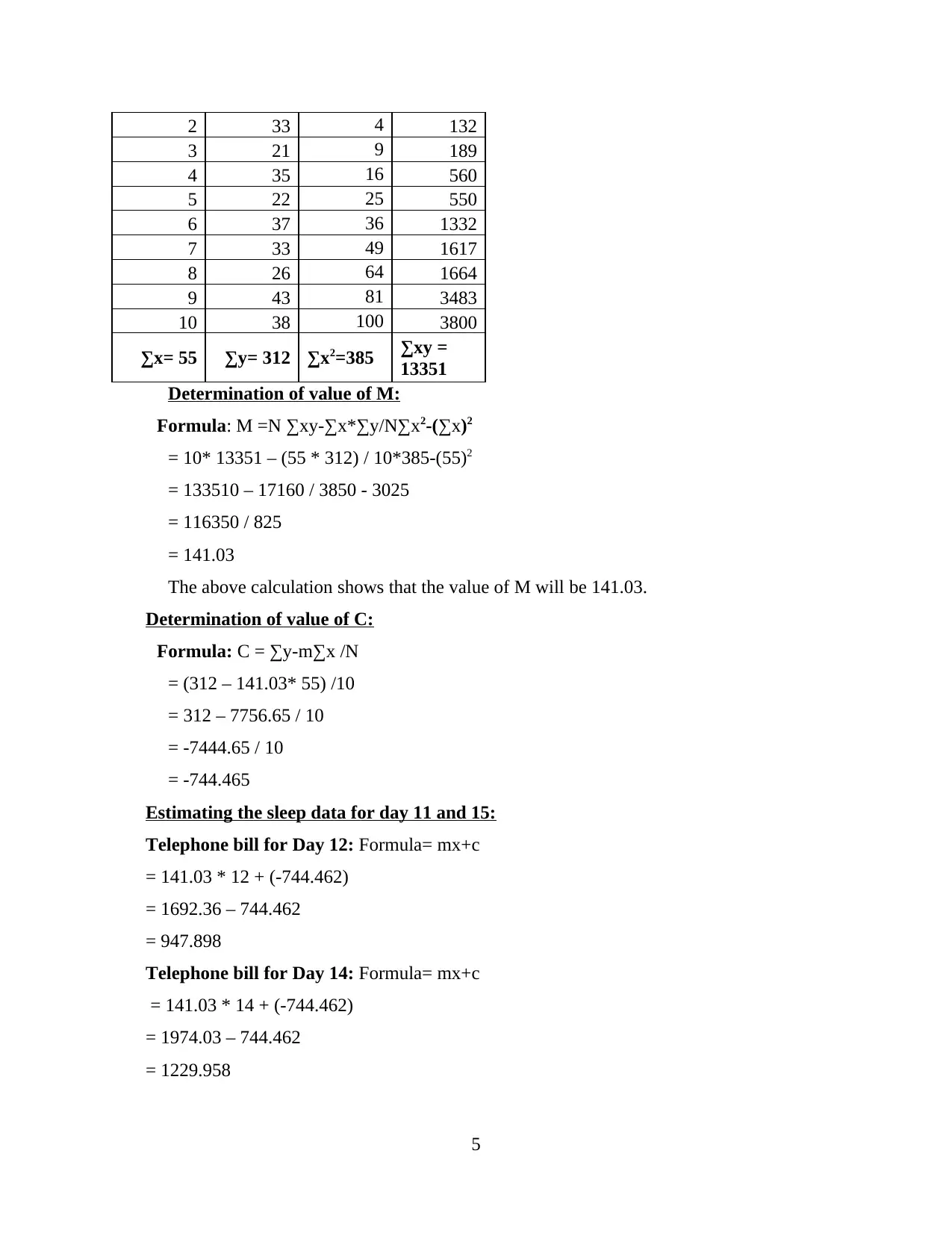
2 33 4 132
3 21 9 189
4 35 16 560
5 22 25 550
6 37 36 1332
7 33 49 1617
8 26 64 1664
9 43 81 3483
10 38 100 3800
∑x= 55 ∑y= 312 ∑x2=385 ∑xy =
13351
Determination of value of M:
Formula: M =N ∑xy-∑x*∑y/N∑x2-(∑x)2
= 10* 13351 – (55 * 312) / 10*385-(55)2
= 133510 – 17160 / 3850 - 3025
= 116350 / 825
= 141.03
The above calculation shows that the value of M will be 141.03.
Determination of value of C:
Formula: C = ∑y-m∑x /N
= (312 – 141.03* 55) /10
= 312 – 7756.65 / 10
= -7444.65 / 10
= -744.465
Estimating the sleep data for day 11 and 15:
Telephone bill for Day 12: Formula= mx+c
= 141.03 * 12 + (-744.462)
= 1692.36 – 744.462
= 947.898
Telephone bill for Day 14: Formula= mx+c
= 141.03 * 14 + (-744.462)
= 1974.03 – 744.462
= 1229.958
5
3 21 9 189
4 35 16 560
5 22 25 550
6 37 36 1332
7 33 49 1617
8 26 64 1664
9 43 81 3483
10 38 100 3800
∑x= 55 ∑y= 312 ∑x2=385 ∑xy =
13351
Determination of value of M:
Formula: M =N ∑xy-∑x*∑y/N∑x2-(∑x)2
= 10* 13351 – (55 * 312) / 10*385-(55)2
= 133510 – 17160 / 3850 - 3025
= 116350 / 825
= 141.03
The above calculation shows that the value of M will be 141.03.
Determination of value of C:
Formula: C = ∑y-m∑x /N
= (312 – 141.03* 55) /10
= 312 – 7756.65 / 10
= -7444.65 / 10
= -744.465
Estimating the sleep data for day 11 and 15:
Telephone bill for Day 12: Formula= mx+c
= 141.03 * 12 + (-744.462)
= 1692.36 – 744.462
= 947.898
Telephone bill for Day 14: Formula= mx+c
= 141.03 * 14 + (-744.462)
= 1974.03 – 744.462
= 1229.958
5
Paraphrase This Document
Need a fresh take? Get an instant paraphrase of this document with our AI Paraphraser
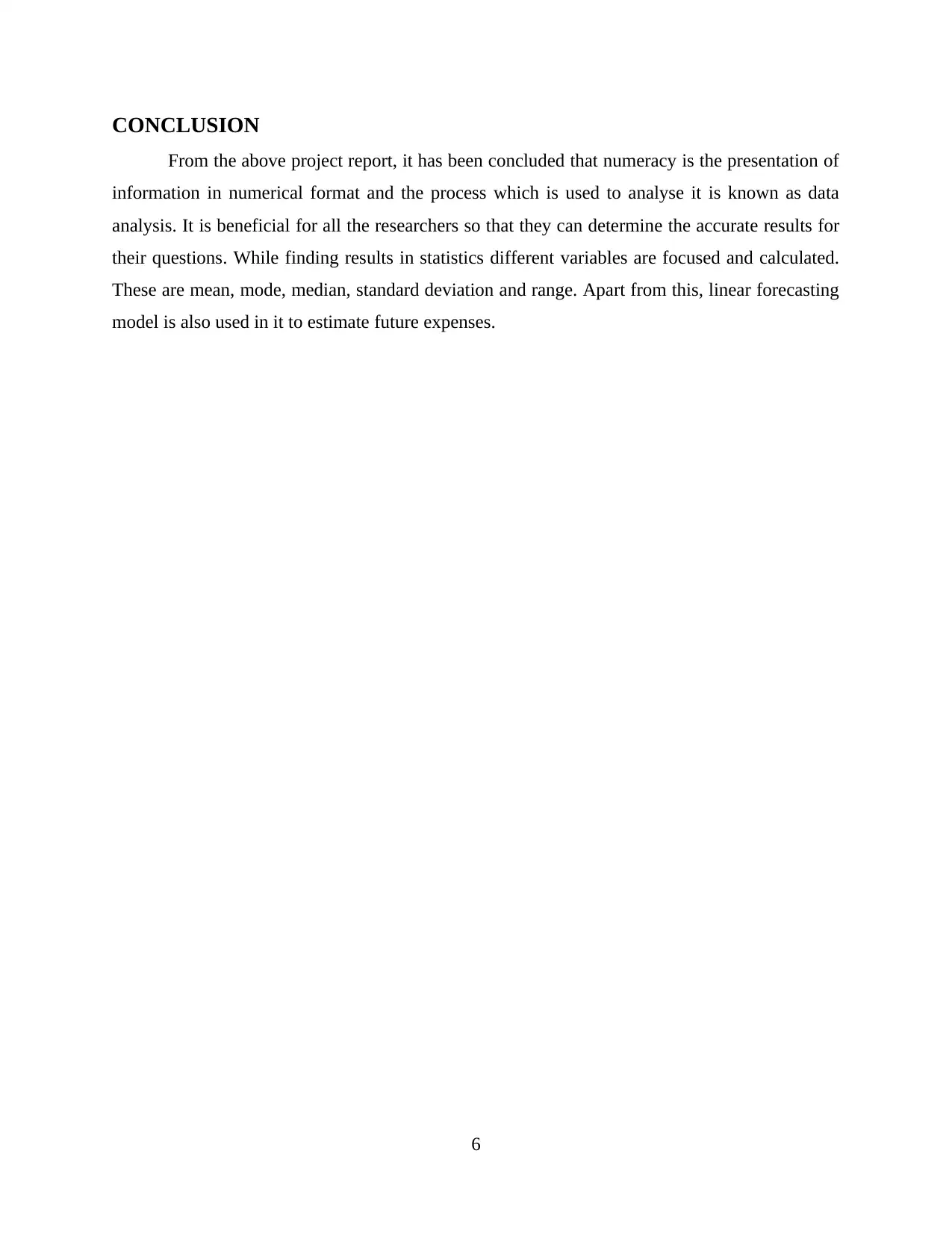
CONCLUSION
From the above project report, it has been concluded that numeracy is the presentation of
information in numerical format and the process which is used to analyse it is known as data
analysis. It is beneficial for all the researchers so that they can determine the accurate results for
their questions. While finding results in statistics different variables are focused and calculated.
These are mean, mode, median, standard deviation and range. Apart from this, linear forecasting
model is also used in it to estimate future expenses.
6
From the above project report, it has been concluded that numeracy is the presentation of
information in numerical format and the process which is used to analyse it is known as data
analysis. It is beneficial for all the researchers so that they can determine the accurate results for
their questions. While finding results in statistics different variables are focused and calculated.
These are mean, mode, median, standard deviation and range. Apart from this, linear forecasting
model is also used in it to estimate future expenses.
6
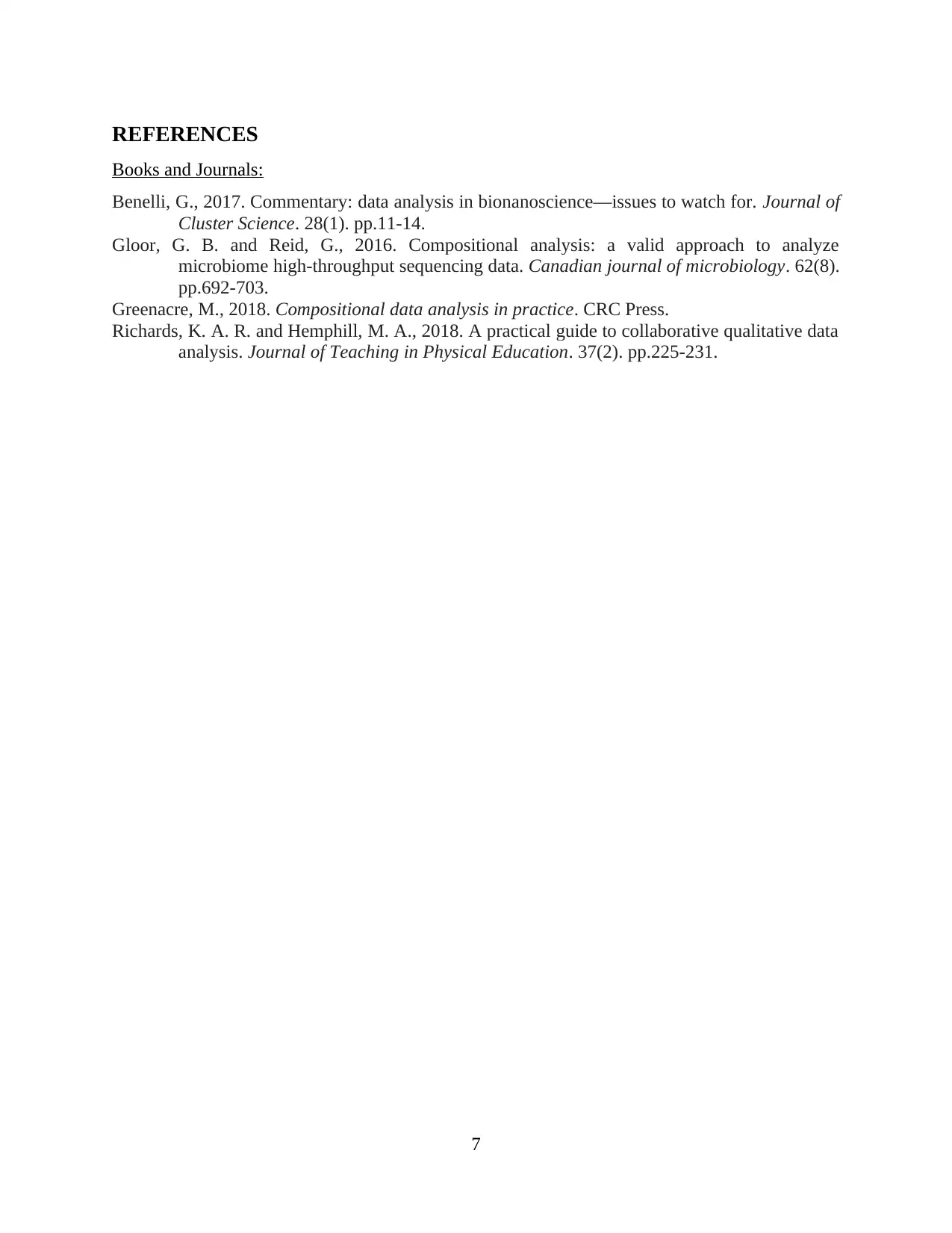
REFERENCES
Books and Journals:
Benelli, G., 2017. Commentary: data analysis in bionanoscience—issues to watch for. Journal of
Cluster Science. 28(1). pp.11-14.
Gloor, G. B. and Reid, G., 2016. Compositional analysis: a valid approach to analyze
microbiome high-throughput sequencing data. Canadian journal of microbiology. 62(8).
pp.692-703.
Greenacre, M., 2018. Compositional data analysis in practice. CRC Press.
Richards, K. A. R. and Hemphill, M. A., 2018. A practical guide to collaborative qualitative data
analysis. Journal of Teaching in Physical Education. 37(2). pp.225-231.
7
Books and Journals:
Benelli, G., 2017. Commentary: data analysis in bionanoscience—issues to watch for. Journal of
Cluster Science. 28(1). pp.11-14.
Gloor, G. B. and Reid, G., 2016. Compositional analysis: a valid approach to analyze
microbiome high-throughput sequencing data. Canadian journal of microbiology. 62(8).
pp.692-703.
Greenacre, M., 2018. Compositional data analysis in practice. CRC Press.
Richards, K. A. R. and Hemphill, M. A., 2018. A practical guide to collaborative qualitative data
analysis. Journal of Teaching in Physical Education. 37(2). pp.225-231.
7
⊘ This is a preview!⊘
Do you want full access?
Subscribe today to unlock all pages.

Trusted by 1+ million students worldwide
1 out of 9
Related Documents
Your All-in-One AI-Powered Toolkit for Academic Success.
+13062052269
info@desklib.com
Available 24*7 on WhatsApp / Email
![[object Object]](/_next/static/media/star-bottom.7253800d.svg)
Unlock your academic potential
© 2024 | Zucol Services PVT LTD | All rights reserved.





